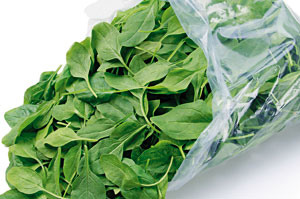 Fresh-cut baby spinach is a very perishable leafy vegetable with a shelf-life of only 7 days when stored at 7°C. The main problems occurring during shelf-life are off-odour development and the quality decay due to the breakage and tissue softening.
Fresh-cut baby spinach is a very perishable leafy vegetable with a shelf-life of only 7 days when stored at 7°C. The main problems occurring during shelf-life are off-odour development and the quality decay due to the breakage and tissue softening. Currently, the off-odour development is still an unresolved problem; the modified atmosphere packaging (MAP) allows the accumulation of volatile compounds that may have negative effects on the product. For example, ethanol and acetaldehyde can be accumulated if MAP conditions induce anaerobic metabolism; some volatiles can be produced as a consequence of tissue starvation. In the case of spinach, the ammonia is produced as a consequence of protein catabolism: the accumulation of ammonia is responsible of leaf dark deterioration.
The effects of MAP conditions on the quality maintenance of fresh-cut spinach have been widely evaluated. In general, gas compositions inside MA packages are low in oxygen (0.8-3%) and high in carbon dioxide (9-12%), because these gas levels allow to reduce respiration rate and the product decay due to microbial growth and off-odour development. The efficacy of MAP can depend on storage temperature, product fill weight, plant respiration rate, film permeability to O2 and CO2, etc.
A group of postharvest scientists (Tudela et al., 2013) evaluated the beneficial and negative effects of different levels of O2 and CO2 on fresh-cut baby spinach shelf-life.
For the study three MAP conditions are tested:
- MAP1 – low O2 with CO2 (stabilizing near 1% O2 + 11% CO2);
- MAP2 – low O2 alone (stabilizing near 1% O2 , CO2 scrubber);
- MAP3 - Moderate O2 with CO2 (stabilizing near 10% O2 + 9% CO2).
Resuts showed that 1) the off-odours develop greatly in the headspace composition, this phenomenon occurred in particular in the MAP1 conditions; 2) the beneficial and negative effects of MAP conditions depended on measured parameters; 3) increasing CO2 concentration significantly increased the cell damage with ammonia release and decreased protein content.
The shelf-life of baby spinach was significantly reduced in the packages with MAP1, whose storage conditions favored the off-odour development compromising seriously baby spinach quality. MAP3 conditions allowed to control off-odour development, but the shelf-life was reduced because the senescence and cell death were accelerated.
The scientists observed that MAP with low O2 allowed to preserve the integrity of tissues, which was associated with lower microbial populations, while MAP with moderate O2 was associated with high microbial populations.
For commercial handling, the shelf-life of fresh-cut baby spinach may not be extended over 7 days at 7 °C unless new technologies, such as micro-perforated films with high CO2 permeability or tools removing off-odours, are implemented. For example, the perforated polymeric packages can reduce the off-odours but limit the shelf-life, while non-perforated packages can prolong shelf-life, but develop the off-odours. Thus, the scientists concluded highlighting the necessity to find new strategies and technologies to control the off-odour development, which continues to be a critical issue for the shelf-life of fresh-cut baby spinach.
Original research. Tudela J.A., Marìn A., Garrido Y., Cantwell M., Medina-Martinez M.S., Gil M.I., "Off-odour development in modified atmosphere packaged baby spinach is an unresolved problem", 2013, Postharvest Biology and Technology, Issue N. 75, pagg. 75-85. Further info: http://www.sciencedirect.com/science/article/pii/S0925521412001883








